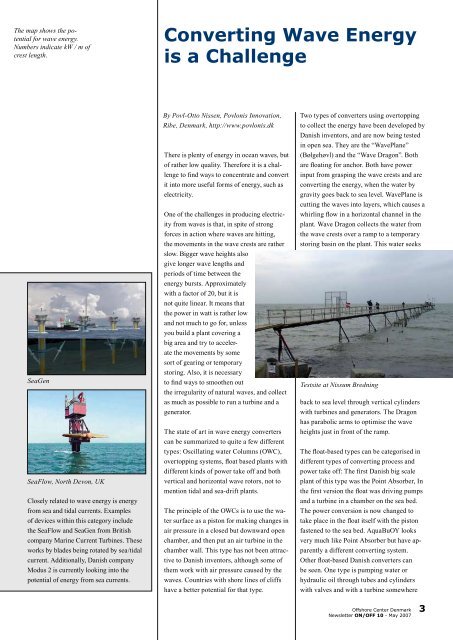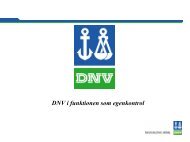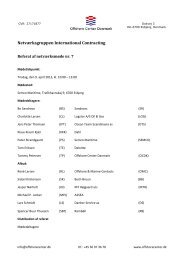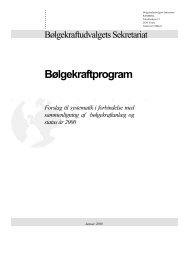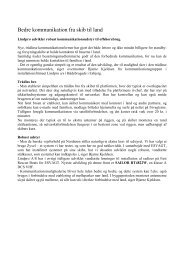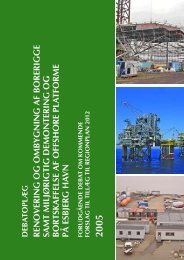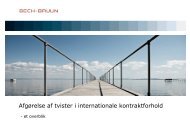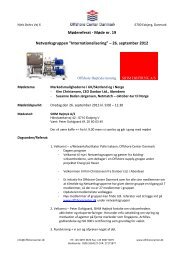Create successful ePaper yourself
Turn your PDF publications into a flip-book with our unique Google optimized e-Paper software.
The map shows the potential<br />
for wave energy.<br />
Numbers indicate kW / m of<br />
crest length.<br />
SeaGen<br />
SeaFlow, North Devon, UK<br />
Closely related to wave energy is energy<br />
from sea and tidal currents. Examples<br />
of devices within this category include<br />
the SeaFlow and SeaGen from British<br />
company Marine Current Turbines. These<br />
works by blades being rotated by sea/tidal<br />
current. Additionally, Danish company<br />
Modus 2 is currently looking into the<br />
potential of energy from sea currents.<br />
Converting Wave Energy<br />
is a Challenge<br />
By Povl-Otto Nissen, Povlonis Innovation,<br />
Ribe, Denmark, http://www.povlonis.dk<br />
There is plenty of energy in ocean waves, but<br />
of rather low quality. Therefore it is a challenge<br />
to find ways to concentrate and convert<br />
it into more useful forms of energy, such as<br />
electricity.<br />
One of the challenges in producing electricity<br />
from waves is that, in spite of strong<br />
forces in action where waves are hitting,<br />
the movements in the wave crests are rather<br />
slow. Bigger wave heights also<br />
give longer wave lengths and<br />
periods of time between the<br />
energy bursts. Approximately<br />
with a factor of 20, but it is<br />
not quite linear. It means that<br />
the power in watt is rather low<br />
and not much to go for, unless<br />
you build a plant covering a<br />
big area and try to accelerate<br />
the movements by some<br />
sort of gearing or temporary<br />
storing. Also, it is necessary<br />
to find ways to smoothen out<br />
the irregularity of natural waves, and collect<br />
as much as possible to run a turbine and a<br />
generator.<br />
The state of art in wave energy converters<br />
can be summarized to quite a few different<br />
types: Oscillating water Columns (OWC),<br />
overtopping systems, float based plants with<br />
different kinds of power take off and both<br />
vertical and horizontal wave rotors, not to<br />
mention tidal and sea-drift plants.<br />
The principle of the OWCs is to use the water<br />
surface as a piston for making changes in<br />
air pressure in a closed but downward open<br />
chamber, and then put an air turbine in the<br />
chamber wall. This type has not been attractive<br />
to Danish inventors, although some of<br />
them work with air pressure caused by the<br />
waves. Countries with shore lines of cliffs<br />
have a better potential for that type.<br />
Two types of converters using overtopping<br />
to collect the energy have been developed by<br />
Danish inventors, and are now being tested<br />
in open sea. They are the “WavePlane”<br />
(Bølgehøvl) and the “Wave Dragon”. Both<br />
are floating for anchor. Both have power<br />
input from grasping the wave crests and are<br />
converting the energy, when the water by<br />
gravity goes back to sea level. WavePlane is<br />
cutting the waves into layers, which causes a<br />
whirling flow in a horizontal channel in the<br />
plant. Wave Dragon collects the water from<br />
the wave crests over a ramp to a temporary<br />
storing basin on the plant. This water seeks<br />
Testsite at Nissum Bredning<br />
back to sea level through vertical cylinders<br />
with turbines and generators. The Dragon<br />
has parabolic arms to optimise the wave<br />
heights just in front of the ramp.<br />
The float-based types can be categorised in<br />
different types of converting process and<br />
power take off: The first Danish big scale<br />
plant of this type was the Point Absorber, In<br />
the first version the float was driving pumps<br />
and a turbine in a chamber on the sea bed.<br />
The power conversion is now changed to<br />
take place in the float itself with the piston<br />
fastened to the sea bed. AquaBuOY looks<br />
very much like Point Absorber but have apparently<br />
a different converting system.<br />
Other float-based Danish converters can<br />
be seen. One type is pumping water or<br />
hydraulic oil through tubes and cylinders<br />
with valves and with a turbine somewhere<br />
<strong>Offshore</strong> <strong>Center</strong> Denmark<br />
Newsletter <strong>ON</strong>/<strong>OFF</strong> 10 - May 2007<br />
3


